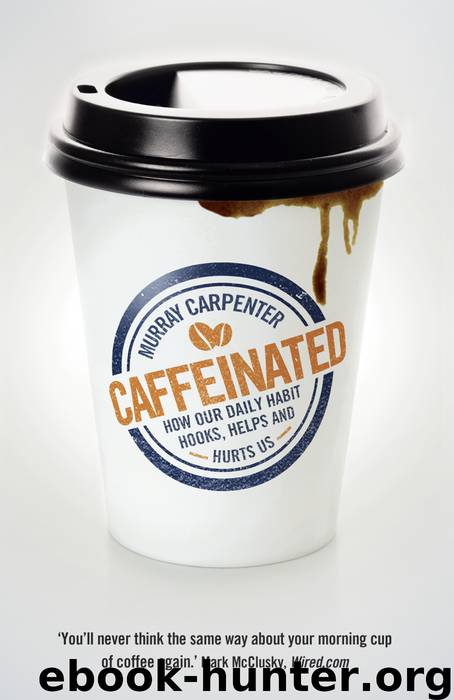Caffeinated by Murray Carpenter

Author:Murray Carpenter
Language: eng
Format: epub
Publisher: HarperCollins Publishers
Published: 2014-03-05T16:00:00+00:00
Many bike racers are enthusiastic caffeine users. One of the dominant United States pro teams is sponsored by 5-hour Energy, and one of the top Canadian pro teams is sponsored by Toronto’s Jet Fuel Coffee. Alison Dunlap, an American cyclist whose kudos include a mountain bike world championship and national championships in mountain biking and cyclocross, is emphatic about its benefits. ‘Caffeine is my wonder drug. I take at least 100 to 200 milligrams in the latter part of a race for a quick pick-me-up,’ she told Bicycling magazine. ‘Don’t caffeinate too early because once you start it’s best not to stop or you’ll experience the crash when the caffeine wears off.’
Some cyclists take caffeine to extremes. Alexi Grewal, the American cyclist who won a gold medal in the 1984 Olympics, used it constantly. ‘Rocket fuel was tea with one Vivarin, double rocket fuel was tea with two,’ he wrote in an essay published in VeloNews. ‘As an amateur among the pros, caffeine injections replaced the pills and the stomach cramps went away too.’
While caffeine is a performance-enhancing drug, it’s purely legal in most cases. But it hasn’t always been legal, and some cyclists have crossed the line. Steve Hegg, an American cyclist who won gold and silver medals in 1984, was disqualified from the 1988 Olympic team after a urine test showed caffeine levels above the legal limit of twelve micrograms per millilitre of urine. In 1994, world champion cyclist Gianni Bugno was suspended from racing after a positive test for caffeine – a urine sample showed 16.8 micrograms per millilitre (he claimed he had ingested nothing more than coffee).
And it is not just cyclists who have been tripped up by caffeine. American track star Inger Miller had to relinquish a bronze medal she’d won in a sixty-metre event at the 1999 world indoor track championship, due to excessive caffeine use. Miller asserted that she’d had only her usual morning coffee and a couple of Cokes after the event, which was sponsored by Coca-Cola. ‘A cup of coffee is one thing, but the small cups they served at the hotel, I don’t know if that’s a cup, a half a cup…. It’s difficult for me to say how much I had as far as micrograms [of caffeine] per litre,’ she told the Associated Press. ‘Who’s to say that I was legal when I was running the race and then the two Cokes I drank that they provided me put me over the limit? I don’t know that. They don’t know that. There’s no way to re-create the situation, yet I’m the one held to high expectations.’
While some athletic organizations still limit caffeine, as they do other performance-enhancing substances, most now do not. Until 2004, the World Anti-Doping Agency and the International Olympic Committee considered twelve micrograms per millilitre in urine to be the maximum legal concentration. But they dropped caffeine from their list of prohibited substances in 2004 because caffeine is so ubiquitous that setting a threshold might lead athletes to be penalised for what others would consider normal caffeine consumption.
Download
This site does not store any files on its server. We only index and link to content provided by other sites. Please contact the content providers to delete copyright contents if any and email us, we'll remove relevant links or contents immediately.
| Adult Children of Alcoholics | Alcoholism |
| Drug Dependency | Gambling |
| Hoarding | Obsessive Compulsive Disorder (OCD) |
| Sexual | Smoking |
| Substance Abuse | Twelve-Step Programs |
The Hacking of the American Mind by Robert H. Lustig(4053)
Right Here, Right Now by Georgia Beers(3890)
Fingerprints of the Gods by Graham Hancock(3708)
Goodbye Paradise(3415)
Bad Pharma by Ben Goldacre(3067)
Happiness by Matthieu Ricard(2852)
More Language of Letting Go: 366 New Daily Meditations by Melody Beattie(2815)
The Social Psychology of Inequality by Unknown(2727)
Drugs Unlimited by Mike Power(2467)
The Plant Paradox by Dr. Steven R. Gundry M.D(2394)
Confessions of a Shopaholic by Sophie Kinsella(2134)
Borders by unknow(2093)
Make Love Not Porn by Cindy Gallop(1964)
Dry by Augusten Burroughs(1964)
Stop Being Mean to Yourself: A Story About Finding the True Meaning of Self-Love by Melody Beattie(1863)
Getting Off by Erica Garza(1842)
Yoga and the Twelve-Step Path by Kyczy Hawk(1731)
Unmasking Male Depression by Archibald D. Hart(1714)
Belonging by Unknown(1705)
